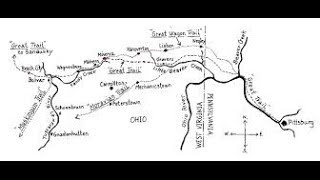Legend of the Great Trail Lost French Gold Ohio USA
Legend of the Great Trail Lost French Gold Ohio USA

There was only one survivor of the ensuing battle, a fellow by the name of Le’sour. In 1820 or so, a diary of the (by then deceased) Le’sour telling the entire story was found.
The legend of this treasure was first printed in the April 3, 1875 edition newspaper, The Minerva Commercial, Minerva, Ohio. (Historians differ on the exact time period. Some researchers suggest 1755, others suggest 1758. Down through the years the legend has grown, and new stories and theories have evolved. Some say it was an impending attack by Indians that triggered the burying of the gold, others say it was an impending attack by British soldiers. Historians have noted an advancing British army under General Braddock in 1755, as well as another advancing army under General Forbes in 1758.) In 1952 mentioned that a Spanish gold coin of the period covered by the treasure was found in the craw of a chicken. Of course this started the gold rush anew. Treasure hunters with modern coin finders have scoured the area in teams. There were also reports of the use of large earth moving equipment that literally changed the face of the landscape while trying to uncover the treasure.

The British were successful in overthrowing the fort and learned of the escape with the one ton in gold coins. Four days out of Pittburgh, the British were catching up to the French, so the French buried their gold to avoid it getting into British hands. It was reportedly buried at the fork of 3 springs. One mile to the west of that location a rock was placed in the fork of a tree. There was only one survivor of the ensuing battle, a fellow by the name of Le’sour and he never returned.
Theres a story very close to this down to the split of 3 creeks in western Massachusetts I dont believe it was French gold. But now that I see the pattern I’m go I’m going for 3 forked creeks 😁
I stand corrected. The above formentioned story did take place in 1758. Not 1755. 1755 was the first attack and it failed. So G.W. came in 1758 and routed the French. In good old American fashion. Kickin’ butt before we were America. Funny how things changed. Kickin’ French Butt in 1758 and then French helping America kick British butt in the Revolution. Then U.S.A. British, French ,and Russia kicking German butt in WW1 and WW 2. Can’t leave out Russia. My girl is Russian.
I know the true story of this Battle. And it was the British that buried Gold in 1755. Prior to the attack. I know where this general location is because I have the land warrants. And the copies of the diaries kept by British soldiers at the time. General Braddock had the Payroll for the British soldiers to be divided up. But by vote it was decided to postpone this until after the attack on Fort Duquesne. And buried the payroll.The British where defeated at Turtle Creek. Not held up.
Your story caught my attention because I just love gold… And lots of it….
Buried in Stark County and the beach City area
My great great grand father and a great uncle uncovered the the gold and kept it a family secrete for generations, it was found south of mapleton near where American landfill sits now… Its my understanding that in 1911 they were rabbit hunting and stumbled upon 2 very old lether satchels tucked into the trunk of a rotted out oak tree
They never will find it
The payroll was roughly 2500.00 in gold for those days. The gold was buried in a cannon barrel. My question is? Who would keep over a ton of gold in a fort? That far west in a area that was known for Indians. There were very little settlements this far west. Gold is not even found in the Pittsburgh area. I think this story is blown way out of proportion. Or made up.
What a dream of unraveling this riddle and finding all this gold, Some have estimated to be worth over a billion dollars. I’m getting my metal detector this is better than lottery.
I found the gold… up my ass kicking footballs…
in any case how does a secret remain a secret among 10 anyones(plural), I’m willing to bet there were a few French diserters(sp) shortly thereafter